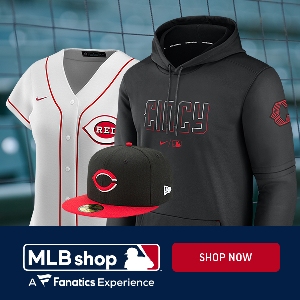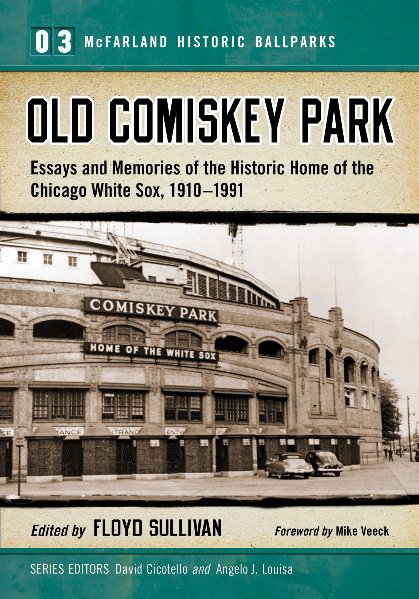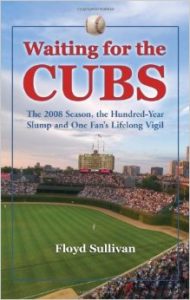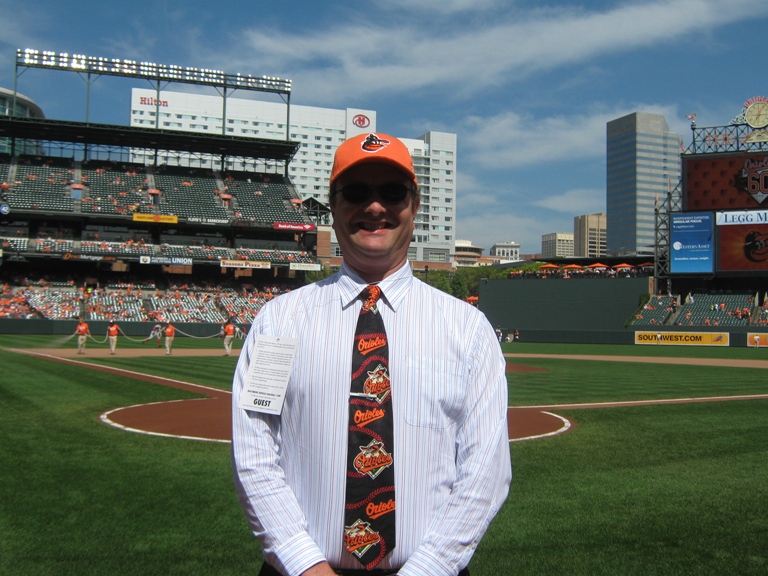Blog
Best Ballparks – Why Great American Is Underrated
Posted by Kurt Smith
I often get asked my opinion on what the best ballparks are, and usually names like Fenway and Camden and PNC pop into my head. Great American in Cincinnati doesn’t make my top five, or maybe even my top ten. It doesn’t quite stand out among the greats visually, the food selection isn’t as varied, and it doesn’t have the retro feel that so many new ballparks have.
Gametime has your cheap Reds tickets…with a lowest price guarantee, panoramic seat view photos, and great last minute deals…even after the game starts!
(See why Ballpark E-Guides loves Gametime here!)
But at the risk of sounding like a boring architect (not that architects are boring, just saying), from a functional standpoint, Great American Ball Park truly is one of the best in baseball. Underrated thing, ballpark functionality, until you’re a season ticket holder.
First, it’s more affordable than most ballparks: for a team that has been competitive in some recent years, the Reds offer some amazing deals for fans. Kids and senior citizens can get half-price tickets, there are several fan clubs that offer discounts, and Reds tickets aren’t that expensive to begin with; even the better seats are relatively affordable.
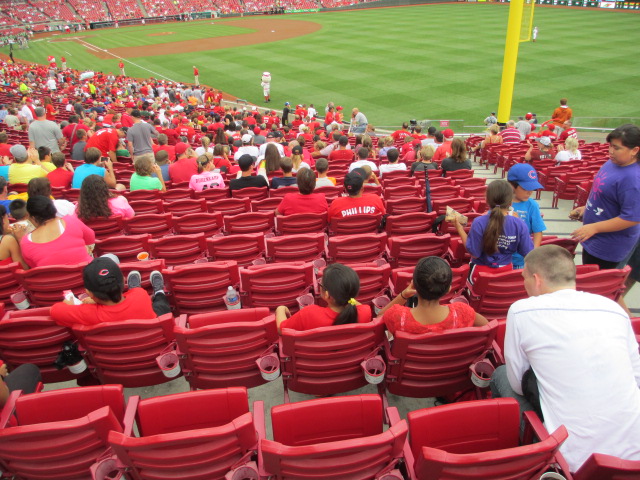
Why are these seats crooked?
Another thing I noticed about GABP is the fan-friendly way the seating is arranged. I kind of chuckled at the big deal they made about the Gap in left field at first, but it does bring more seats closer to the action. The curvature of the seating bowl on the first base side and the way the seats are arranged allow for a straight ahead view with no neck twisting.
I searched all over the ballpark, and other than the bleachers missing a bit of the warning track, I couldn’t find a single obstructed view…including seats from which you can’t see the scoreboard.
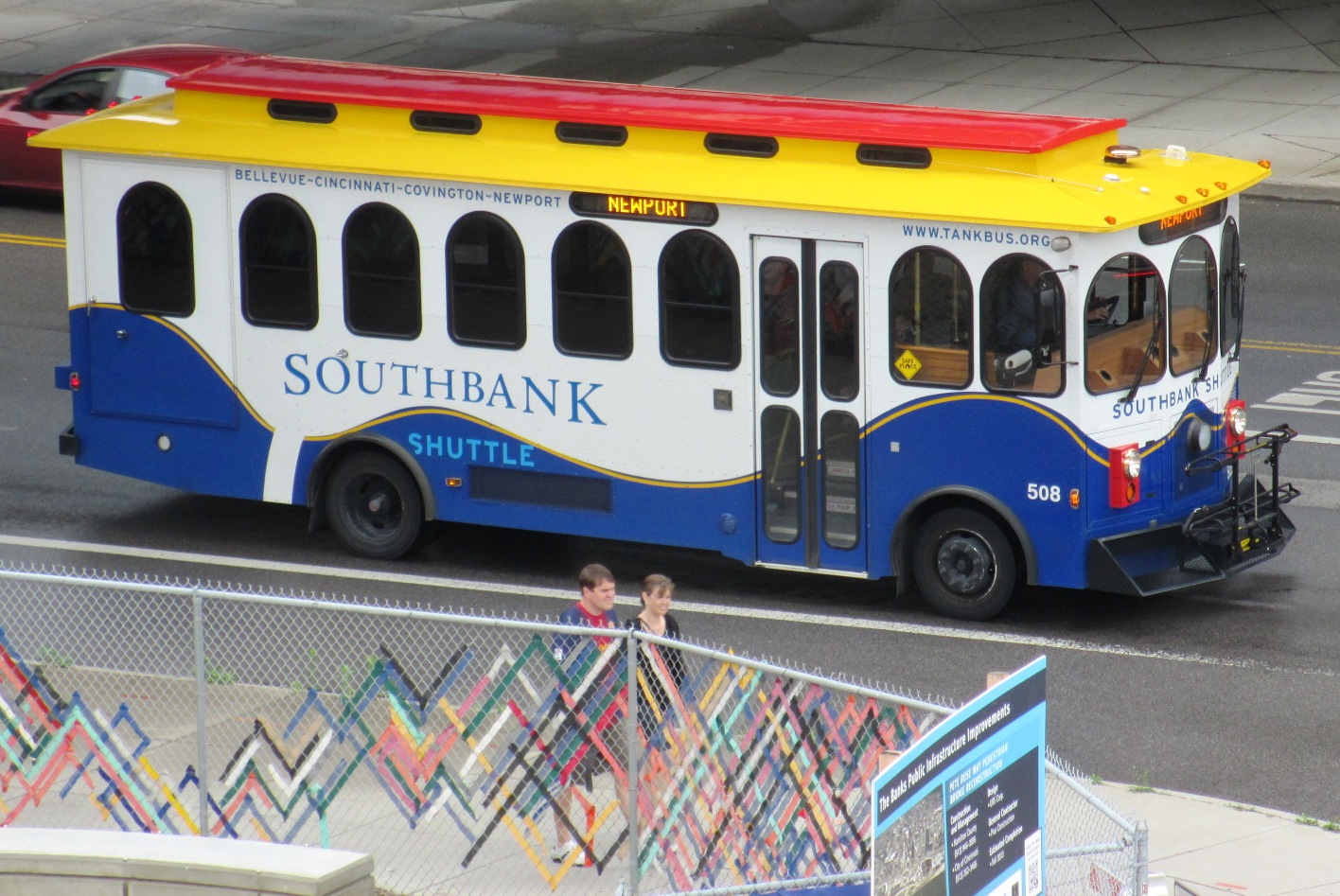
It’s a beautiful day in the neighborhood…
Few ballparks—especially ballparks planted in the heart of a city—are easier to get to than Great American. There are three nearby interstates, and not only is there abundant parking in the garages and lots nearby, there is much cheaper parking across the river in Newport and Covington. From either town you can use the inexpensive Southbank Shuttle to the ballpark. And now the new streetcar makes a visit to Cincinnati with a ballgame thrown in much easier.
Leaving the ballpark, drivers can move in any direction and find an easy way home. Parking is as affordable as in any ballpark too.
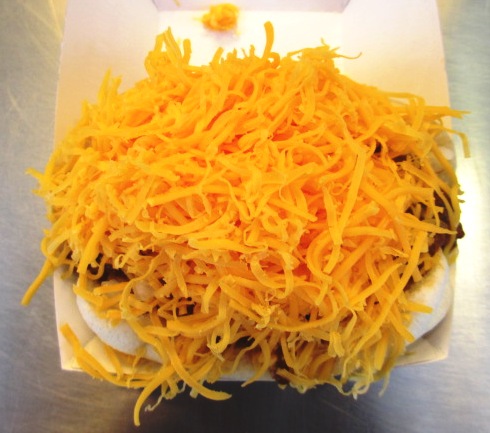
It’s baseball. There’s a hot dog in there somewhere.
The food selection at GABP isn’t as varied as other ballparks…as far as I know there aren’t any “executive chefs”…but if you want a taste of the popular joints in the Cincinnati area, they’re all here: Skyline chili, LaRosa’s pizza, Montgomery Inn BBQ, Frisch’s Big Boy burgers, and Penn Station subs. Plus about a half dozen different kinds of Kahn’s dogs and Queen City sausages, and an affordable restaurant in left field with cool stuff like Mammoth Fries.
Need to keep the kids occupied? There’s a whole kids play area with a wiffle ball field, and Reds employees even pitch to the kids.
Don’t wait till you get to the ballpark to get your Cincinnati Reds gear…
Order your caps, jerseys, and more now at MLBShop.com and save!Click here to order your Reds gear today!
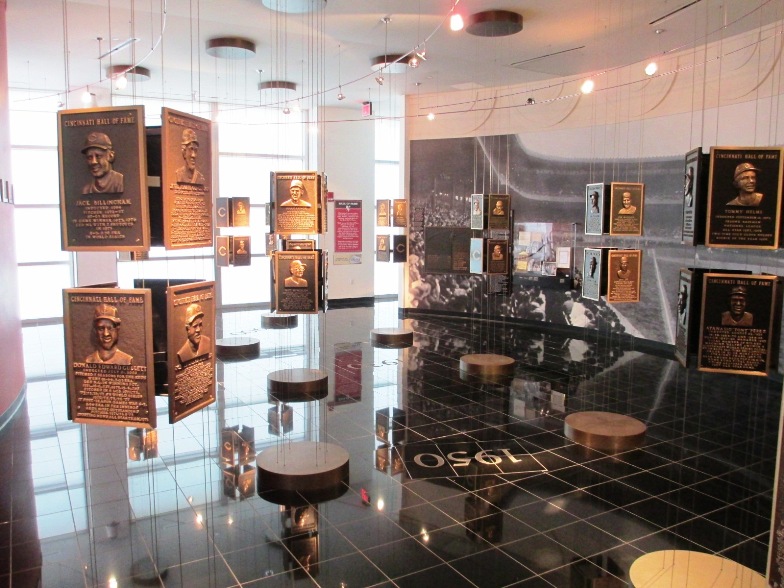
“No running in here, kids!”
All that and more than enough post-game options, whether you want a meal at the Holy Grail or entertainment in Newport-On-The-Levee. And arguably the best team Hall of Fame in baseball.
It’s all here.
Great American, by ballpark standards, is something of a no-frills venue. Most don’t rank it among the best ballparks in baseball. But it’s fan-friendly, family-friendly, transportation-friendly and wallet-friendly, and I can’t say all four of those things about too many ballparks. It’s perfectly wonderful for one thing: watching baseball.
Which, as we may have forgotten in the age of millennial-friendly party areas, luxury suites and restaurants (and GABP has all of those too), is why the venues are built in the first place.
If you’re planning a visit to Great American, check this out.
(Note: this article contains affiliate links. If you use an affiliate link to make a purchase, Ballpark E-Guides earns a commission, at no extra cost to you. Thanks for your support!)
A Cheap Day At The Cincinnati Ballpark
Posted by Kurt Smith
Finding a cheap Reds ticket and other deals in my trip to Cincinnati wasn’t difficult. Because of what I do, I’ve learned a few tricks to get the most for my dollar at the ballpark…taking advantage of special offers, giveaway nights, etc.
On my second day in Cincinnati, I hit the trifecta of bang for the ballpark buck.
I usually get the cheapest seat I can get at the game, because when I’m running around taking pictures I’m usually not sitting in that seat much anyway, and it’s usually well into the game before I have an opportunity to sit. Even then, I’m restless thinking I’ve missed something.
Gametime has your cheap Reds tickets…with a lowest price guarantee, panoramic seat view photos, and great last minute deals…even after the game starts!
(See why Ballpark E-Guides loves Gametime here!)
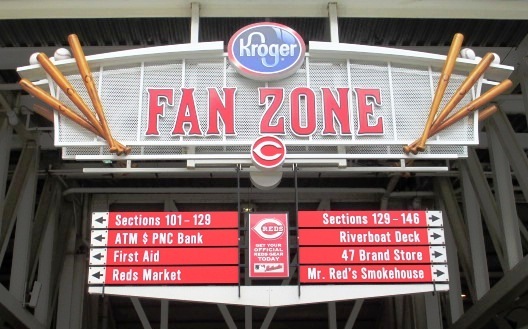
I probably should have checked this out…
So while I ordered a ticket for the Friday night game on StubHub, I decided to just buy the Saturday ticket at the box office, where there aren’t any fees. There were plenty of tickets available for the game, surprisingly, so I knew it wouldn’t be a problem.
Friday night I bought an Outer View Level seat for Saturday’s game for $11 and no fees. Not a great seat, of course, but I didn’t care. It was, as I’ve stated, a cheap Reds ticket.

A few of the very prevalent kiosks at Great American. Maybe they don’t like talking to people.
Saturday night the Reds were giving out some fairly nice T-shirts…with “Reds” on the front in American flag colors, and Jay Bruce’s name and number 32 on the back (also in U.S. flag style). Jay Bruce sponsors a group called “Bruce’s Battalion”, and buys tickets for members of the military for most home games.
It’s a pretty nice T-shirt…would probably go for $30-35 at the ballpark, at least.
The Reds and LaRosa’s Pizza also run a very popular promotion: if the Reds pitchers strike out 11 batters in a game, LaRosa’s gives a free pizza to everyone at the ballpark. You read that right…LaRosa’s gives away upwards of 30,000 pizzas.
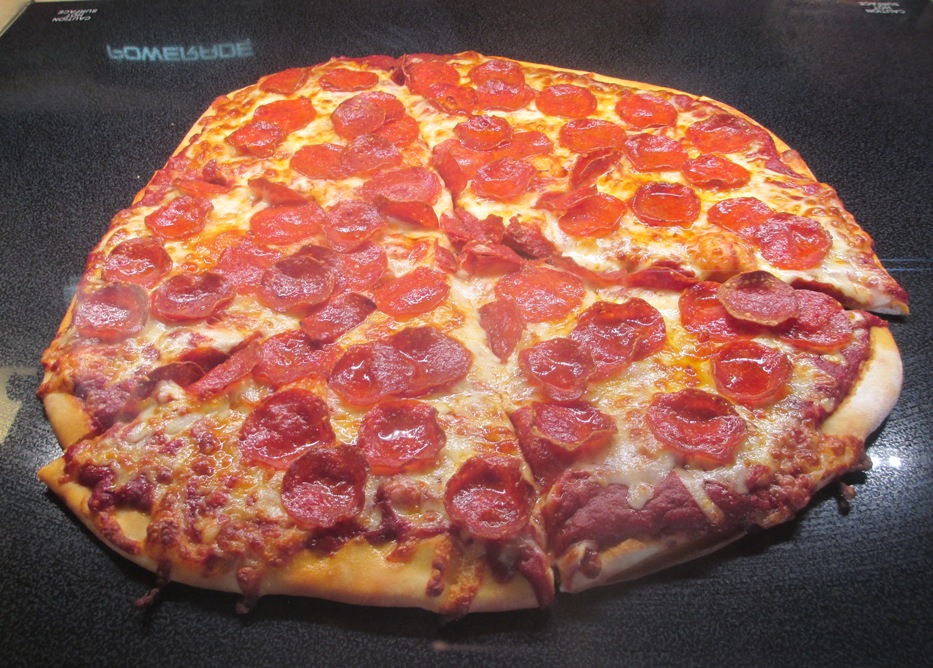
LaRosa’s is pretty good as ballpark pizza goes. And I’m a pizza snob.
Mat Latos was on the mound for the Reds, and he sat down a bunch of swinging Mariners. The total mounted and the crowd became more enthusiastic with each whiff…eight, nine, then ten. By this point I was sitting high up in the rafters behind home plate, so I had a decent view of everything.
With ten strikeouts on the board some of the crowd started chanting “Pizza! Pizza!” every time a batter reached two strikes. At one point a Mariners hitter had two strikes on him and took a half-swing. The home plate umpire appealed to third base, who signaled safe, the batter didn’t swing. He was loudly booed. It was everything that’s great about baseball.
But Latos did soon pull it off, and the Reds faithful of course went nuts as the scoreboard informed them that they would all receive a free pizza. Then I saw on the bottom of the board: “starting tomorrow”. Unfortunately I was leaving town the next morning. Rats.
But Wade, the nice fellow running the Sharonville LaRosa’s, was happy to honor the ticket, and I got my first taste of LaRosa’s…which as it turns out is pretty good pizza, better than any of the well-known chains in my South Jersey neighborhood. It was a personal pie, certainly enough for one person and I was able to pile four toppings on it. And the price couldn’t be beat.
Don’t wait till you get to the ballpark to get your Cincinnati Reds gear…
Order your caps, jerseys, and more now at MLBShop.com and save!Click here to order your Reds gear today!
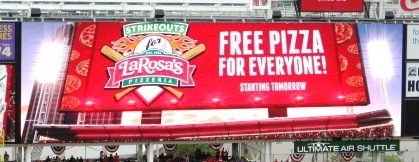
If you want it today, you’re just gonna have to buy it here.
I think this is a great promotion for both the Reds and LaRosa’s…they could run commercials with the crowd chanting, and the “Pizza!” chant could become a Reds tradition. Then again, I’m not sure LaRosa’s wants to give out 35,000 pizzas so frequently…I’ve heard the Reds pitching has been costing them a lot of money this season.
Regardless, it was a great score for the author of Ballpark E-Guides. For a grand total of $11, I nailed down a cheap Reds ticket, a nice Reds T-shirt, and a delicious pizza. If you want to throw in the $1 O’Doul’s I drank for being a designated driver, then throw in a non-alcoholic beer for a total of $12. Parking in Newport cost me $2. So for $14 I scored close to $50 in value there at normal prices.
Not bad for a sport many people think they can’t afford anymore. Try this page if you want some tips for cheap tickets.
(Note: this article contains affiliate links. If you use an affiliate link to make a purchase, Ballpark E-Guides earns a commission, at no extra cost to you. Thanks for your support!)
The First Professional Baseball Team
Posted by Kurt Smith
I’ve always known that Cincinnati was the home of the first professional baseball team, but until I visited the Reds Hall of Fame and Museum, it always puzzled me how the Red Stockings could be the first baseball team…because how could there be just one team? Wouldn’t they need someone to play against? Did they just stand on the field practicing until another team filled out all of the legal forms? Maybe they signed the contract for their ballpark the day before the Phillies did or something?
I wouldn’t say it kept me up at night, I knew there had to be an explanation, but it was just one of those things that puzzled me a bit.
But now I get it…one less thing to waste brain power pondering.
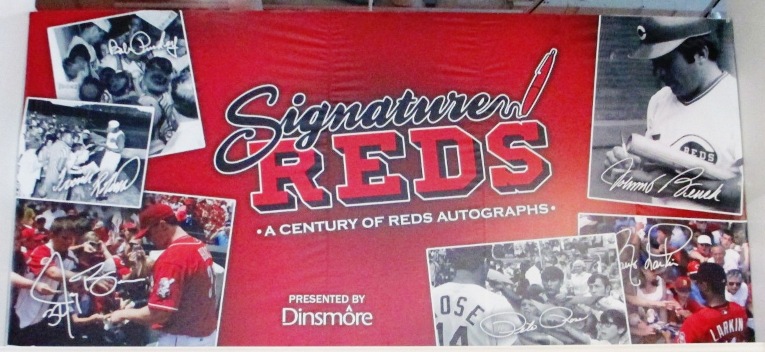
Even from way back in the days when they had no one to play against!
The Reds Hall tells the story—that the Red Stockings were the first professional baseball team because they were the first team whose players were actually paid to play baseball. Other teams’ owners balked at the idea of ballplayers being professionals (some things never change), but the Red Stockings were willing to pay players. And by doing so, they attracted some of the best talent around. No doubt radio show hosts in other cities began demanding that their team owners start paying players.
This all-star team of professionals went on a tour in 1869 and won everywhere they went, finishing their first ever season unbeaten and actually drawing some crowds on the road. (I think hot dogs were $1.50 back then.) This was back in the days before gloves and catcher’s masks and the DH, proving that people will play baseball for money even if they’re risking life and limb.
Their second season was marked by dissolution and player bickering (that didn’t take long), despite that the team resumed its greatness, winning all but one game against the Brooklyn Atlantics, in an 11-inning affair. Eventually some players moved to Boston, as did the Red Stockings name—now the Red Sox, of course.

Did they even wear gloves back then?
The team disbanded, and then a new Red Stockings team joined the newly formed National League in 1876. This team was banned from the National League for…get this…serving beer at ballgames. Nowadays a team might be banned from the league for not serving beer.
Finally in 1881 another Red Stockings team (they loved that name for some reason) joined the rival American Association, and in 1889 they moved to the National League, replacing the bootlegging Red Stockings team that had been booted. In the move, they changed their name to the Reds, probably to save on stitching costs.
So the current incarnation of the Cincinnati Reds that we all know today wasn’t exactly the first professional baseball team, but you could argue that Cincinnati simply hit a few bumps in the road to become America’s first iconic baseball town.
There is a great deal of history when it comes to Cincinnati baseball, and it’s as good a place as any for a team to feature a Hall of Fame and Museum that is a microcosm of baseball’s Hall in Cooperstown. The Reds Hall of Fame is definitely worth the visit if you’re coming to Great American Ball Park, if only to learn how there could only be one “first professional baseball team”.
But of course, there’s a lot more to know about Great American. Especially if you’re visiting for the first time.
Gametime has your cheap Reds tickets…with a lowest price guarantee, panoramic seat view photos, and great last minute deals…even after the game starts!
(See why Ballpark E-Guides loves Gametime here!)
(Note: this article contains affiliate links. If you use an affiliate link to make a purchase, Ballpark E-Guides earns a commission, at no extra cost to you. Thanks for your support!)
The Black Sox Scandal and Forgotten Team of 1919
Posted by Kurt Smith
The 1919 World Series and Black Sox scandal, even today, may have been baseball’s darkest hour. The revelation that eight players from one of the game’s historically best teams had thrown the Series was an earthshaking shock to fans across the country, it resulted in tough new rules that in turn resulted in the permanent expulsion of one of the game’s greatest players, and it’s been poignantly immortalized in literature and cinema.
Much of the focus of the 1919 Series today is, obviously, on the Black Sox and on Shoeless Joe Jackson, the superstar Sox outfielder for whom fans seem to have the most sympathy.
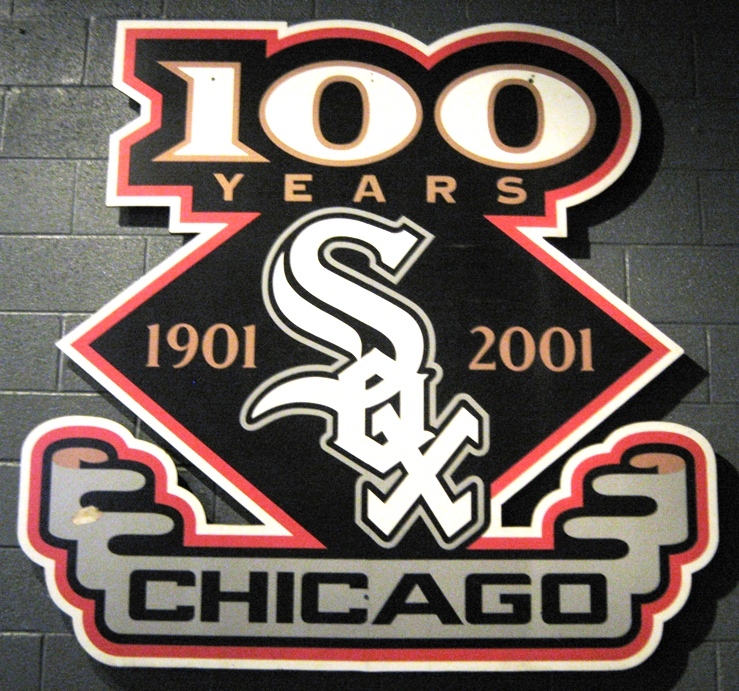
And Shoeless Joe is still one of their best known players.
The book and movie “Eight Men Out” (both are excellent…check them out if you’re a baseball fan) paint a picture of a few ballplayers furious at their penny-pinching owner, falling in with a crooked crowd and ultimately getting thrown out of baseball forever. The book “Shoeless Joe”, and subsequent “Field of Dreams” movie, fictionally chronicle the return of Shoeless Joe Jackson to a corn field in Iowa and his ultimate redemption.
What gets lost in the story is the World Series winner…a Cincinnati Reds team that no one believed stood a chance against the mighty White Sox.
At the Reds Hall of Fame, a film is shown about the history of the Cincinnati Reds. The team’s second World Series title in 1940 is said to have brought a collective sigh of relief to the city…they had finally won a World Series honestly.
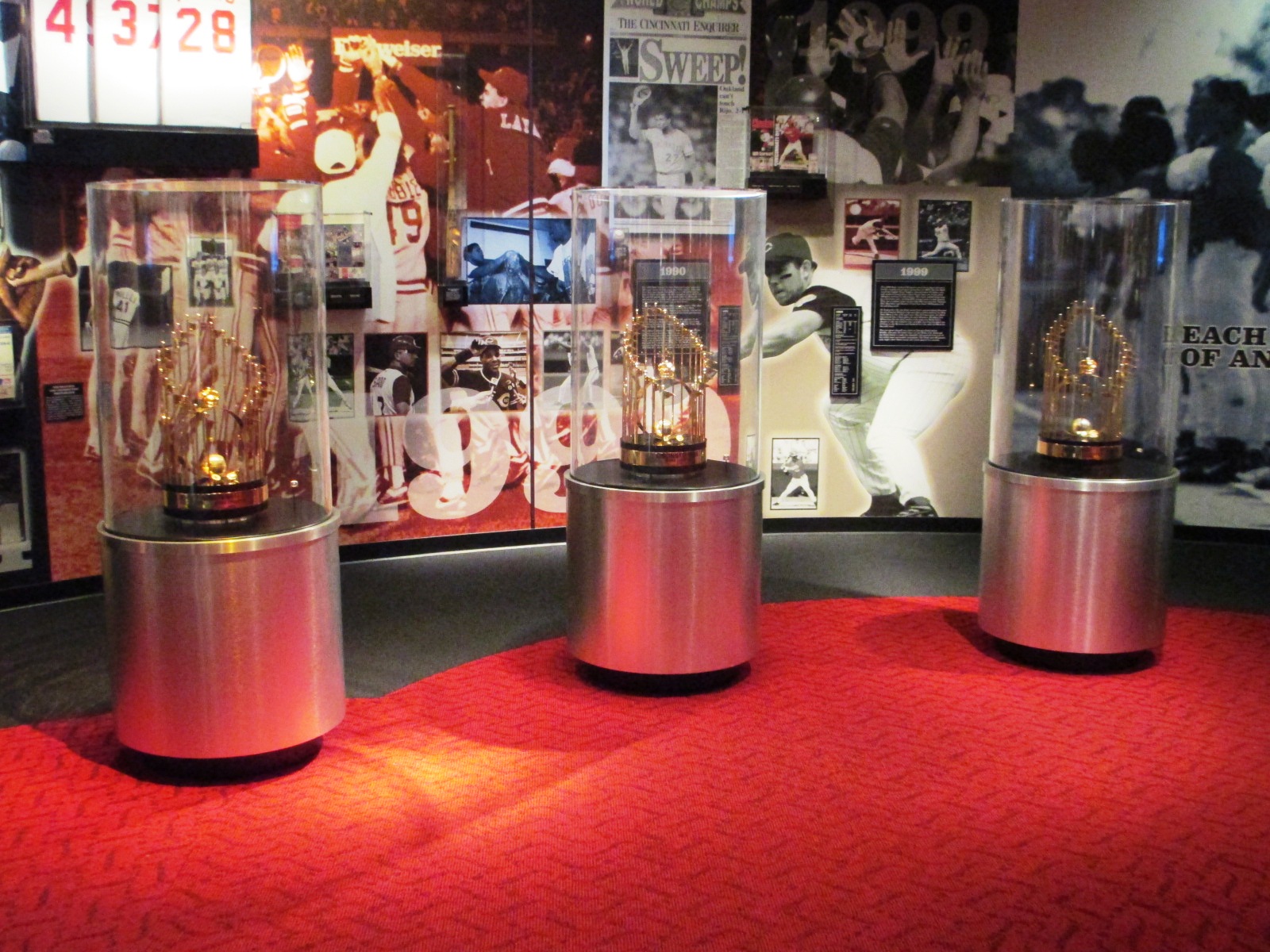
Yes, 1919 is in there.
There are some folks who believe that the Reds would have beaten the White Sox even if a few of the Sox’s best players hadn’t agreed to make Arnold Rothstein richer.
Everything is possible in baseball.
The 1990 World Series between the Reds and the loaded Oakland Athletics seemed like a mismatch, but the Reds not only won, they swept the Series convincingly. If someone questioned the legitimacy of the 1969 Series when the Miracle Mets topped the Orioles, they wouldn’t have been laughed at.
The 1919 Reds, despite not having been any great shakes before that season, were hardly pushovers. They won 96 games—the White Sox won just 88—and while they had little in offensive might beyond Edd Roush and Heinie Groh, they did possess a tremendous pitching staff. Dutch Reuther was 19-6 with a 1.82 ERA; Hod Eller was 19-9, 2.39; Ray Fisher was 14-5 and 2.17. That is some mean starting pitching.
A staff that strong, presumably, would have an edge in a short series…as we saw in 1988, 2010 and in many other triumphs of the underdog. As my father always said, good pitching always stops good hitting. (It’s kind of ironic that the first NL champion Reds team had little offense but great pitching, while the later Big Red Machine teams of the 1970s were just the opposite. Don’t tell Reds fans it’s all about pitching.)
Looking at some details of the 1919 Series, it’s certainly possible to see ways that the Reds could have triumphed in a clean contest.
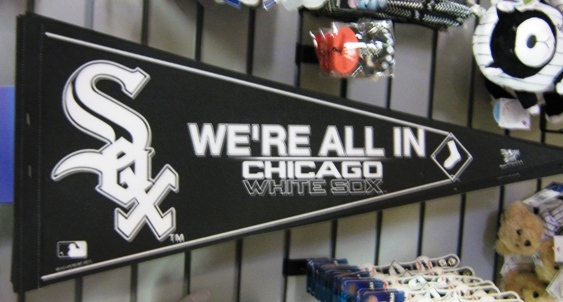
This was their slogan in 2011, I believe. Ironic in retrospect.
Shoeless Joe Jackson and Buck Weaver played too well for players supposedly trying to lose. Jackson hit .375, the highest in the Series, and threw out five baserunners, while Weaver hit .324, well above his .272 lifetime average.
It’s fair to say Weaver was telling the truth about his unwillingness to participate, and it’s not hard to believe Jackson’s similar assertion…Shoeless Joe did have a .286 average in games the White Sox lost, but that could arguably be attributed to better Reds pitching on the mound for those games, and in a short series, that is probably only 2-3 hits.
Three other players in the fix, Chick Gandil, Happy Felsch and Swede Risberg, had lifetime averages of .277, .293 and .243, respectively…good hitters if not great, but it’s not as though it’s positive they would have been the offensive difference had they been playing to win. Gandil hit .290 in 1919 and .233 in the Series; Felsch hit .275 and .192; Risberg, .256 and .080 in the Series (Risberg did walk five times, when strikeouts would have been easiest to fake).
That’s significant, I won’t argue, but for Gandil and Felsch only one or two more hits in the Series would have been normal for them…and remember they were up against some good Reds pitchers, so that’s no guarantee. The other position player in on the scandal, Fred McMullin, was a utility infielder who had only two at-bats in the Series.
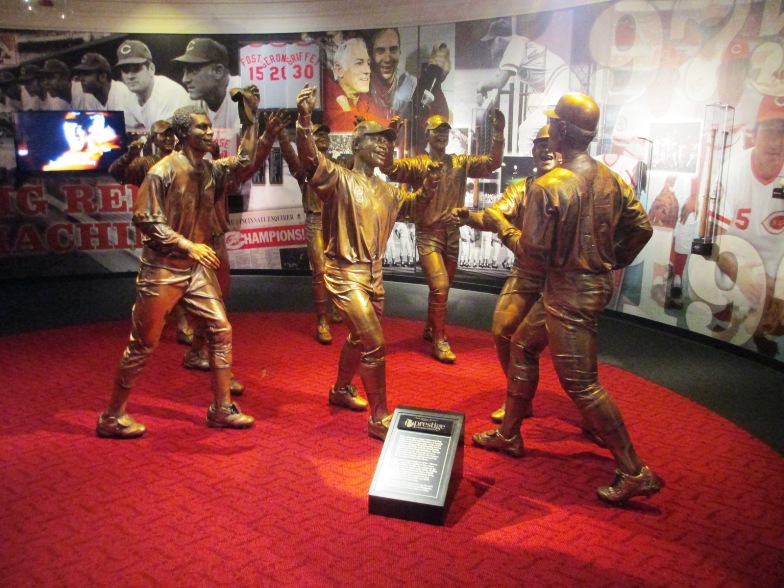
“Great win guys! They almost played their butts off!”
With the Reds pitching as strong as it was, it’s not hard to imagine that even if there were no Black Sox scandal, that the Reds pitching could still have effectively shut them down. The Sox scored just 20 runs in eight games, and that’s with two of their best hitters hardly whiffing on each at bat. It was mostly the deliberate errors during games, and meatball pitches from Eddie Cicotte and Lefty Williams, that lost the Series for the White Sox.
So what if Cicotte and Williams had performed to their considerable abilities? Cicotte’s ERA was 1.82 in the 1919 season; had he given up two runs in his starts—questionable given the Reds offense, but for the sake of argument—that might have been enough for the Reds to have won Game 1 and possibly Game 4, since the White Sox scored a total of just one run in those games.
Lefty Williams’s ERA that year was 2.64; the Sox scored just two runs in Game 2, so that could have turned out as a Reds victory as well. Williams obviously handed the win to the Reds in Game 8, so it’s hard to say whether the Reds would have won there.
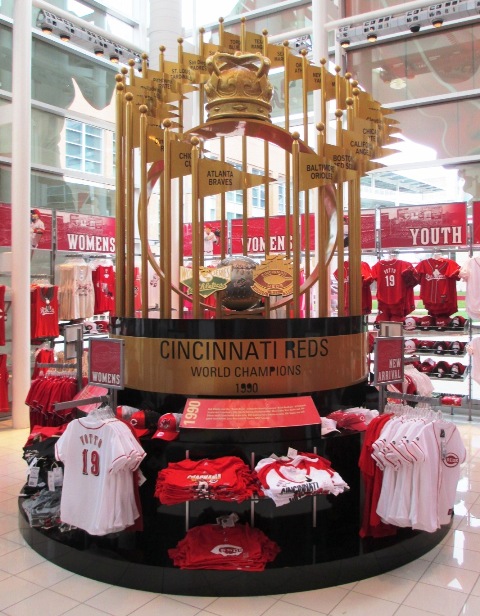
It’s moot.
I’m not trying to positively assert that the Reds would have won in 1919 had the Series been clean; bookmakers were going heavily with the White Sox before the rumors of a fix, and they usually know what they’re doing, as anyone who bets on football knows.
I’m only suggesting that the 1919 Cincinnati Reds deserve some credit for a National League championship, a 96-win season and a stellar pitching staff, and that there are conceivable scenarios where in a legitimate Series, the Reds could have taken down the mighty White Sox after all. Stranger things have happened.
Unfortunately, we’ll never know.
(Note: this article contains affiliate links. If you use an affiliate link to make a purchase, Ballpark E-Guides earns a commission, at no extra cost to you. Thanks for your support!)
5 Guaranteed Rate Field Tips For Newbies | Chicago White Sox
Posted by Kurt Smith
If you’re going to see the White Sox for the first time, I’ve put together some of my favorite Guaranteed Rate Field tips for you below. It may not present the same challenges as Wrigley Field on the north side, but to some, that’s what makes Guaranteed Rate Field a fun place.
Here are some tips you should know for your first trip.
Gametime has your cheap White Sox tickets…with a lowest price guarantee, panoramic seat view photos, and great last minute deals…even after the game starts!
(See why Ballpark E-Guides loves Gametime here!)
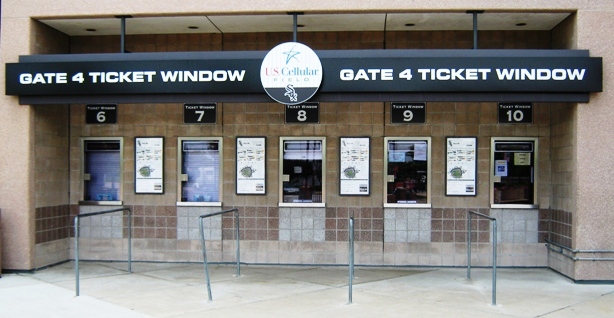
Hmmm…which window has that “generous” guy?
Visiting Guaranteed Rate Field Tip #1: Get tickets from the box office. That is, unless you can find a crazy great deal from a third party seller; but the White Sox don’t sell out most games and they don’t charge fees at the box office. You can save quite a few bucks this way, especially buying multiple tickets.
The only exceptions to this rule are Cubs games and perhaps Yankees and Red Sox games on July/August weekends.
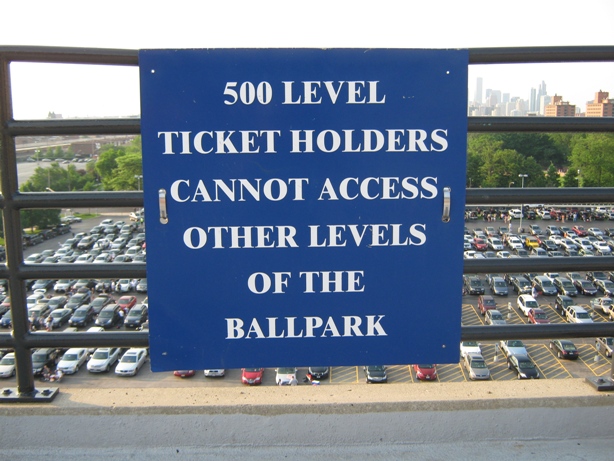
You didn’t check your E-Guide?
Visiting Guaranteed Rate Field Tip #2: Avoid the upper (500) level seats! Yes, they’re cheap and yes they offer a nice panoramic view. They’re also restricted; fans with upper level tickets are not allowed to access other levels of the ballpark.
This can be a real downer for a traveling fan who likes to walk around an entire ballpark to see what food offerings and statues are there, and that’s most of us. 500 level seats are for people looking for a White Sox game on the cheap, not first time visitors. If you want to go cheap, go for the outfield corners.
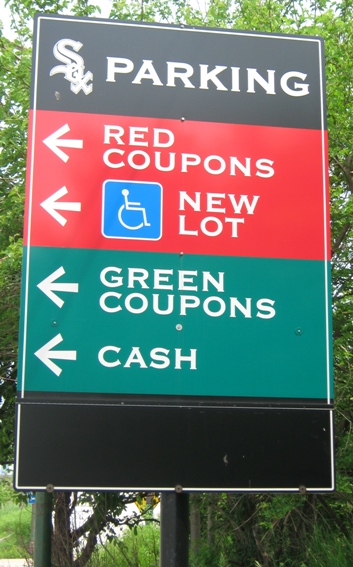
Nothing but old lots that don’t take coupons to the right.
Visiting Guaranteed Rate Field Tip #3: Drive only on Sundays. The CTA Red and Green Lines both serve Guaranteed Rate Field well, as does Metra Rail. All three have stations close enough to the ballpark that it’s in view from the station platform.
You can drive to the game if you want to be a part of a tailgating scene that is certainly respectable, but it’s a fairly high parking cost. Parking is much cheaper on Sundays, though, so save the brats and grill for the Sunday afternoon games and use CTA or Metra (or the Pace Express!) for the rest of them.
Don’t wait till you get to the ballpark to get your Chicago White Sox gear…
Order your caps, jerseys, and more now at MLBShop.com and save!Click here to order your White Sox gear today!

Chicago dogs in Chicago. When common sense just works.
Visiting Guaranteed Rate Field Tip #4: Have a Comiskey Dog. Or Burger. The Comiskey dogs are the Chicago-style dogs at the ballpark; it’s a dog the way it’s meant to be in Chicago, with yellow mustard, chopped onions, neon green relish, pickle spear, tomato chunks, sport peppers and celery salt. Or get the Comiskey Burger…with cheddar cheese, pico de gallo and other Chicago Dog ingredients.
There’s other great food here like Bobak’s sausages and elotes, but the Comiskey dogs and burgers are the true taste of Chicago.
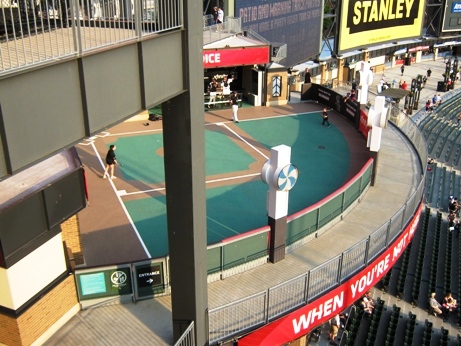
The short porch will jack up your kid’s power numbers.
Visiting Guaranteed Rate Field Tip #5: Bring the kids. Guaranteed Rate has one thing on its neighbor in Wrigleyville; it’s much more kid-friendly. Not only is it a whole lot cheaper to bring the little ones to a game, there’s a terrific Xfinity Kids Zone in left field, with interactive games and a wiffle ball field on the upper level.
And not to be derisive of the smaller crowds the Sox are drawing, but it is a bit less worrisome with little ones to not be in a concourse jammed with people as Wrigley so frequently is. Wait until the kids are a little older for the Friendly Confines…for now take them to a game on the South Side.
There you go…some first time tips for visiting Guaranteed Rate Field. There’s a whole lot more to know of course…I’ve offered plenty of Guaranteed Rate Field advice on this blog, including how to choose a great seat, land a solid parking spot, and choose what to eat at a White Sox game.
Thanks for reading, and please support our sponsors!
(Note: this article contains affiliate links. If you use an affiliate link to make a purchase, Ballpark E-Guides earns a commission, at no extra cost to you. Thanks for your support!)
3 Extra Guaranteed Rate Field Tips
Posted by Kurt Smith
Hopefully this website has helped you with some decent Guaranteed Rate Field tips…I would have liked to know about that Comiskey Burger. But here are a few extras things you might like to check out while you’re at the “Rate” (sigh).
Gametime has your cheap White Sox tickets…with a lowest price guarantee, panoramic seat view photos, and great last minute deals…even after the game starts!
(See why Ballpark E-Guides loves Gametime here!)
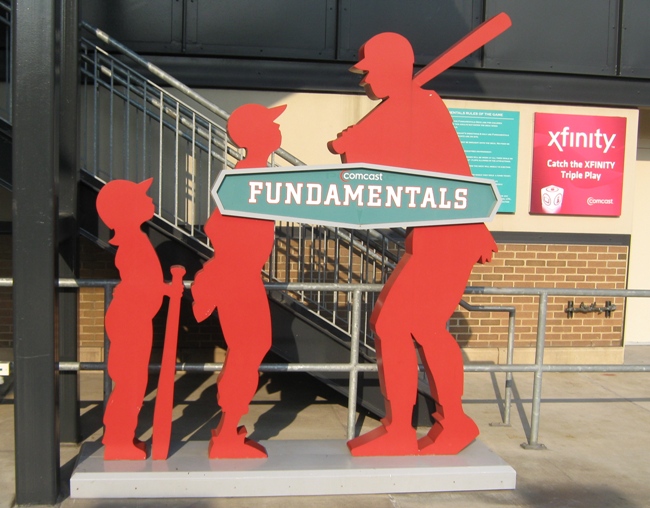
Because when you think youth baseball, you think Xfinity.
Extra Guaranteed Rate Field Tips, #1: The Fundamentals Kids Zone. The Comcast FUNdamentals area is located in the left field corner…kids can play on a wiffle ball field, and learn all kinds of baseball skills completely free of charge. It’s really impressive, as if the White Sox were attempting to make up for not having a kids zone for years.
It is also accessible from the upper level, so you don’t have to spend for a lower level seat just to bring the kids to happy zone. Nearby is a “Rookie’s Club” selling kid-sized portions of food.
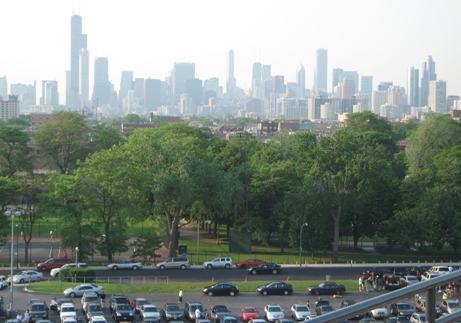
Before all those big buildings were there, you could see Wrigley from here.
Extra Guaranteed Rate Field Tips, #2: The View From The Upper Level. As mentioned before, if you have an upper level seat you aren’t allowed in the lower sections. But it’s not all bad, since the ramps are on the northern side of the ballpark, and at the top on a clear day you can have a fine view of the Chicago skyline. This is even worth the trip if you’re sitting in the lower level to begin with.

When they put lockers in for towels, it’s gonna rock.
Extra Guaranteed Rate Field Tips, #3: The Rain Room. The Rain Room in the large outfield concourse area is a throwback to the days of late White Sox owner Bill Veeck, who never ran out of ways to improve the baseball experience for fans. It is a small area where fans can duck out of the heat and have a cool mist sprayed on them. The original shower was brought over from the old Comiskey, but is only on display now as an ad for some plumbing outfit. If you want to get some odd looks, head for the Rain Room during an April night game.
There are also the player statues in the outfield, the tailgating scene before the game, and the humorous special promotions the White Sox feature, like 80s Mullet Night (OK, my past mullet isn’t something I’d admit to…not for upper level tickets, anyway). All good stuff. But these are three of my favorite Guaranteed Rate Field tips.
Don’t wait till you get to the ballpark to get your Chicago White Sox gear…
Order your caps, jerseys, and more now at MLBShop.com and save!Click here to order your White Sox gear today!
(Note: this article contains affiliate links. If you use an affiliate link to make a purchase, Ballpark E-Guides earns a commission, at no extra cost to you. Thanks for your support!)
Where’s The Love For White Sox Fans?
Posted by Kurt Smith
I have great respect for White Sox fans. It can’t be easy. For all of the romanticizing of the 86-year championship drought endured by Red Sox fans and the continuing looking to next year that Cubs fans endured, White Sox fans never seemed to garner any sympathy for the 88 seasons that they pulled for the Pale Hose without seeing a championship.
Surely, thousands of fans attended games through their entire lives without ever once seeing their heroes on top of the baseball world.
Gametime has your cheap White Sox tickets…with a lowest price guarantee, panoramic seat view photos, and great last minute deals…even after the game starts!
(See why Ballpark E-Guides loves Gametime here!)

2001 was year 84 of the drought.
In the years from 1919 to 2005 after the Black Sox, the White Sox had four playoff appearances, losing in the first round of each one…the World Series of 1959, the American League Championship Series of 1983 and 1993, and the League Division Series of 2000. They had experienced almost every bit the level of futility as the Red Sox or Cubs, if not the devastating near misses. Yet the White Sox seemed to garner nowhere near the compassion.
One possible reason is, of course, the so-called Curse of the Black Sox. Bambino and Billy Goat curses are easier for fans to pour their heart into…after all, what did Ted Williams or Carl Yastrzemski or Ernie Banks or Ryne Sandberg do to deserve to never win a title in their careers? But it seems more just for the baseball gods to punish a team that desecrated the sanctity of the World Series.
To this day the biggest names associated with the White Sox to most fans are Charles Comiskey, Shoeless Joe Jackson, Buck Weaver and Eddie Cicotte…names that are just as well known (thanks partly to Eliot Asinof and Hollywood) as Frank Thomas, Luke Appling, Harold Baines or owner Jerry Reinsdorf, who paid for the 2005 championship drought-ending team. Even if you are sympathetic to Shoeless Joe, as many fans are, that can’t be an easy legacy to champion.
I’ve asked some White Sox fans what they think is the reason the Sox’s drought gets dismissed in comparison. The consensus is generally that while the Black Sox may have something to do with it, there are some other possible reasons too.
For one, White Sox never seemed to suffer the colossal near misses that the Red Sox did.
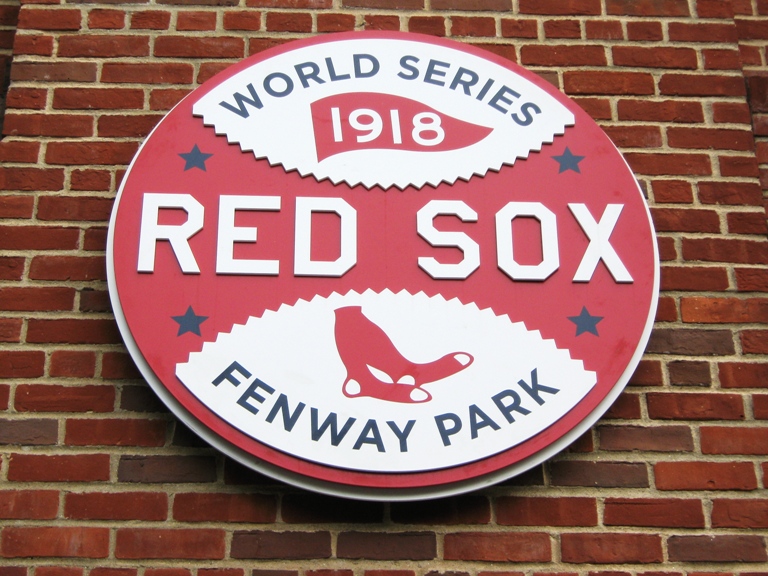
They probably figured they’d be putting up another banner well before 2004.
The Red Sox made four World Series in their 86-year drought; each one went seven games and ended in a Red Sox loss. In 1986 the Red Sox blew a two-run lead in the tenth inning of Game 6, coming within one strike of winning the Series before a ground ball trickled through Bill Buckner’s legs.
The Curse of the Bambino was by far the easiest of all to really believe in, given the crushing defeats that always seemed to befall the Red Sox. Until the NLCS of 2003 and the infamous Bartman game, the Cubs seemed to simply suffer from a usually incompetent roster more than a black cloud waiting to unceremoniously deflate fragile hopes.
Another reason a White Sox fan suggested to me is the lack of a well-known rivalry with a team whose success on the field has been the opposite of futility. The Red Sox have, of course, the fierce rivalry with the Yankees that has lasted ever since the sale of Babe Ruth to the Bronx. The Yankees are the most successful team in major sports history, with 27 World Series championships.
In second place in World Series titles is the St. Louis Cardinals…who scored a miraculous 11th in 2011, and who were for many years the Cubs’ biggest rival. While interleague play has turned Cubs and White Sox fans into snarling crosstown enemies, the Cubs fans rivalry with Cards fans is still going pretty strong.
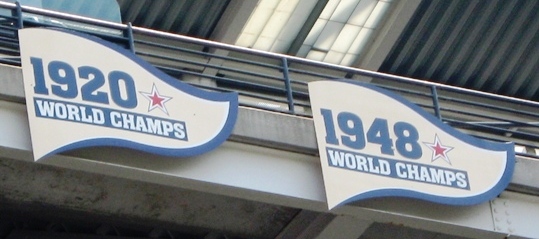
Don’t worry, we’ll get another star pitcher when Feller retires.
By contrast, the White Sox have never had a team in their division racking up titles and bringing crowing fans into Comiskey/U.S. Cellular/Guaranteed Rate from out of town.
There’s a rivalry of sorts with the Indians, but the Tribe has been enduring a pretty long championship drought of its own—64 years as of this writing and probably counting. White Sox fans don’t care much for Tigers fans, but the Tigers have only put four titles on the board, just one more than the Sox.
Then there’s the characterization of the teams’ fan bases.
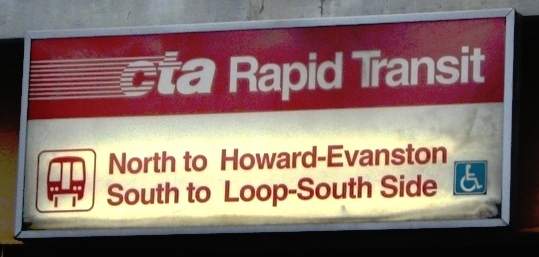
Two directions…two entirely different baseball worlds.
Wrigley Field and Guaranteed Rate Field in Chicago are separated only by a half-hour train ride on the CTA Red Line. But they might as well be in different countries. At Wrigley a baseball game is a celebration that engulfs the entire neighborhood, from the rooftops of nearby houses to the drinking establishments where the party often continues, win or lose.
At Guaranteed Rate, fans are there to see a game, and the only partying is in the parking lots—although there is a considerable amount of happy times there. There is almost no ballpark neighborhood to speak of, and the South Side has a reputation for being a place people don’t want to be at night, so if you’re not interested in baseball, you’re less likely to enjoy yourself at a White Sox game. But at least won’t be surrounded by mai-tai drinking cell phone users, and you can better follow what’s going down on the field.
Sure, what the Cubs endured was rough, and being a Red Sox fan for those 86 years could have made normal people suicidal. That aside, it’s not like White Sox fans haven’t had to endure more than their share of heartache.
They won 99 games in 1983, only to lose an ALCS to a seemingly destined Orioles club. They had to face a well-funded Blue Jays team in 1993 and hung tough until a six-game ALCS loss. The 2000 Sox won 95 games, the best in the American League, but fell to the Mariners in four games of the ALDS.
For 40 years, Sox fans had to live with their team corrupted into a loss in their last appearance in the World Series. The 1959 World Series loss to the Dodgers had to be tough too…Sox fans knew very well by then how long it could be before their team could make it back to the Big Show, and indeed the White Sox wouldn’t be back again for another 46 years.
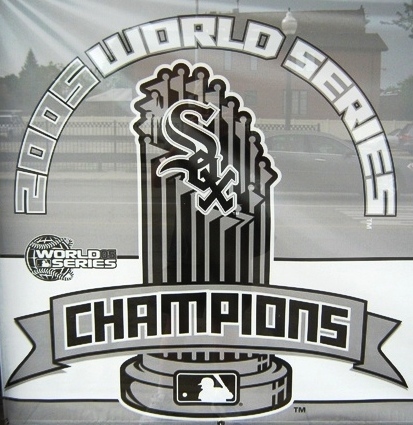
So what’s a measly 88 years?
That the Sox swept the Astros in four games in the 2005 Series probably saved the hearts of some older Sox fans, who would have had enough without a nail-biter seven-game Series.
To grow up in the city of Wrigley Field and the Cubs and become a White Sox fan, one must acquire or already possess a nonconformist nature. It could be argued that White Sox fans are more dedicated than most in baseball, even if the White Sox aren’t among league leaders in attendance. Not only did they go 88 years without a title, they did it without soulful books and poetic tributes from sportswriters about a suspected hex that had been placed on their team.
So here’s to the White Sox fans…and all their loyal dedication to the Sox without forming support groups.
Don’t wait till you get to the ballpark to get your Chicago White Sox gear…
Order your caps, jerseys, and more now at MLBShop.com and save!Click here to order your White Sox gear today!
(Note: this article contains affiliate links. If you use an affiliate link to make a purchase, Ballpark E-Guides earns a commission, at no extra cost to you. Thanks for your support!)
Old Comiskey Park – Book Review
Posted by Kurt Smith
Most baseball fans will tell you that the demolition of their old home ballpark was a very sad day in their lives, and Old Comiskey Park was no slouch in its historical value. As an Orioles fan I still feel that way about Memorial Stadium. But time moves on, and the job of an author is to capture what was.
My friend Floyd Sullivan, author of “Waiting for the Cubs”, has done an outstanding job of just that, with his collection of essays from writers, players and fans about the old ballpark on the South Side of Chicago. The full title of the tome is “Old Comiskey Park: Essays and Memories of the Historic Home of the Chicago White Sox, 1910-1991“.
If you are an older Sox fan especially, this book should be your Bible when it comes to their beloved former home.
The book begins with a terrific piece from Carl Rinder, describing the early history of the area and the three neighborhoods bordering Comiskey: Bridgeport, Douglas, and Chinatown. This is followed by Richard Smiley’s essay of the construction of the new ballpark in 1910, replacing the then state of the art Sox Park.
From there the book details the history of events that took place at Comiskey…like the first ever All-Star Game, with the two teams led by the heavyweight managers of the day–John McGraw and Connie Mack; the Negro League games played by the American Giants of Chicago and the popular East-West games that were often played there; the 1919 “Black Sox” World Series, the 1959 World Series, the 1983 ALCS, and three other All-Star Games.
Sullivan himself contributes a section dedicated to other events held at Comiskey. If you’ve ever seen the movie “Cinderella Man”, you know that Joe Louis claimed James Braddock was the toughest fighter he ever fought. That fight took place at Comiskey. There were legendary wrestling matches, it was the home of the Chicago football Cardinals, even roller derby events. And of course, the Beatles played Comiskey Park.
My personal favorite parts of the book are the bits about the inimitable Bill Veeck, who owned the Sox for a spell and was known for his imaginative promotions.
Dan Helpingtine contributes a great bit about Veeck…including, of course, the story behind “Disco Demolition Night”. It wasn’t Veeck’s finest hour.
Gametime has your cheap White Sox tickets…with a lowest price guarantee, panoramic seat view photos, and great last minute deals…even after the game starts!
(See why Ballpark E-Guides loves Gametime here!)
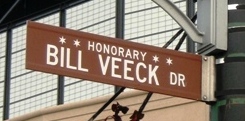
Veeck as in wreck.
But Veeck’s contributions to the game are often underappreciated…such as the home run celebration, extremely common today but unusual when the scoreboard first exploded at Comiskey. That was not a popular celebration among other teams…which was precisely why it stayed.
And I didn’t know this: the tradition of Harry Caray singing ”Take Me Out To The Ballgame” started at Comiskey. Caray was the White Sox announcer, and Bill Veeck urged him to lead the crowd, knowing that everyone in the stands could sing it better than he could and wouldn’t be afraid to join in. If that doesn’t cement Veeck as a promotional genius, I don’t know what does.
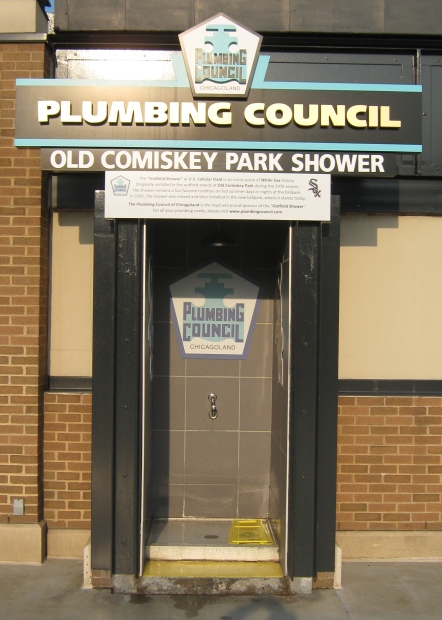
Guaranteed Rate Field does indeed have the shower.
Another excellent piece comes from Greg Prince, author of the popular Mets blog “Faith and Fear in Flushing”. Prince tells his story of being in Chicago on business and wanting to visit Wrigley, but with the Cubs out of town he decides reluctantly to visit Comiskey instead…and while there he is shocked by what a true gem Comiskey turned out to be as a home of baseball, and to this day favors it to Camden Yards and PNC Park.
Towards the end are the somber reflections of players, personnel and fans as they share their memories and the emotion of losing their childhood second home. Interestingly, there is a consensus that it needed to be replaced among most, very unlike the angry fan reaction to the demise of Tiger Stadium. But this isn’t of much comfort to fans. There are quite a few tearjerker moments, something older Tigers and Orioles fans can certainly understand.
“Old Comiskey Park” is a large volume, and it works best as a coffee table book that you can open to any page and read a story about something that happened at Comiskey…like the first All-Star Game, the East-West Negro League games, or Disco Demolition Night. Or the great White Sox teams, like the Go-Go Sox or the South Side Hitmen, or the personalities like Charles Comiskey, Al Simmons or Bill Veeck.
For anyone who loved the old park, it’s an absolute must have…and for any White Sox fan or student of baseball history, it’s a great read. Check it out.
(Note: this article contains affiliate links. If you use an affiliate link to make a purchase, Ballpark E-Guides earns a commission, at no extra cost to you. Thanks for your support!)
Book Review: Waiting For The Cubs
Posted by Kurt Smith
(Note: this review and this book were written before the glorious Cubs triumph of 2016. Eamus Catuli!)
Sometimes I think that if the Cubs won the World Series, it would be a gigantic letdown.
When the Red Sox finally broke their 86-year jinx in 2004, it was made much sweeter by the way it happened…an unprecedented comeback from a 3-0 deficit to defeat the hated Yankees in the ALCS. That would have been memorable even without a curse, but it lived up to how sweet a long-awaited World Series victory could truly be for Red Sox fans.
What could the Cubs do to match that, especially given that their futility has reached (and now passed) a full century? The White Sox went longer than the Red Sox did without a championship—a full 88 years—but the baseball world outside of Chicago almost yawned when they breezed past the Astros in the 2005 World Series.
There hardly seems any way an end to the Cubs drought could match the buildup. Floyd Sullivan, author of “Waiting For The Cubs: The 2008 Season, the Hundred-Year Slump and One Fan’s Lifelong Vigil”, doesn’t seem overly worried about the possibility.
Most people appreciate that it’s tough being—or more correctly staying—a Cubs fan. But until one reads Sullivan’s account of the 2008 season, one doesn’t really feel the effect of a lifetime of devotion without a payoff and with no proverbial light at the end of the tunnel.
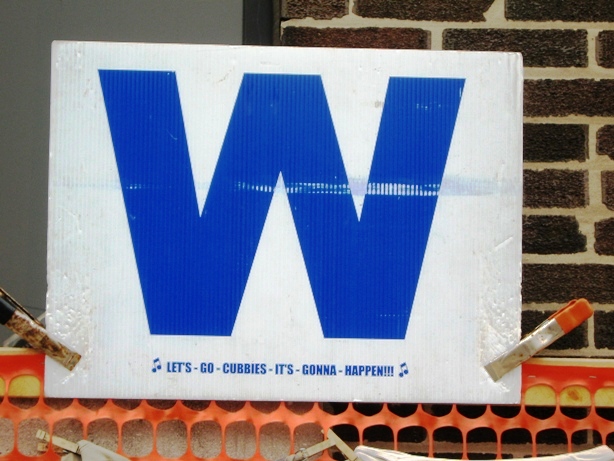
A blue W. For “Victory”.
Throughout the book, despite that the Cubs have one of their best seasons in years, Sullivan—and his equally devoted Cubs fan family—are always expecting the other shoe to drop, always waiting for the imminent disaster to befall their heroes.
One could hardly blame them, especially after the 2003 NLCS, when Steve Bartman’s unfortunate blunder sparked a legendary collapse. Despite that a writer of Sullivan’s skill could have easily put a few gratuitously heart-wrenching pages in his book about the incident, he almost skims over the subject, informing the reader that “if you’re interested in reliving it, Google Steve Bartman.”
Sullivan writes from a personal angle, but the book never feels like someone telling his own story. Instead he shares the pain and occasional euphoria of being a Cubs fan, something his family and friends, and certainly any fan, can relate to. At one point he humorously shares the possible double meaning of what his children get written on their Wrigley brick dedication, which reads simply, “Thanks, Dad”.
His family has moved from Chicago to York, Pennsylvania; and while this precludes frequent trips to the Friendly Confines each year, it does enable him and his family to see the visiting club in both Philadelphia and Pittsburgh, which they do frequently, with a trip to Washington thrown in. His description of Nationals Park, which opened in 2008, is spot-on accurate.
His tales of trips to Pittsburgh are hilariously fraught with the dangers of the western PA Turnpike (with which I can definitely identify), but also a couple of weather miscalculations…one trip ends with a game postponed in what he believed was hardly a downpour, as a result he cancelled a later trip on his own due to torrential rain and missed a full nine innings of Cubs baseball at PNC Park.
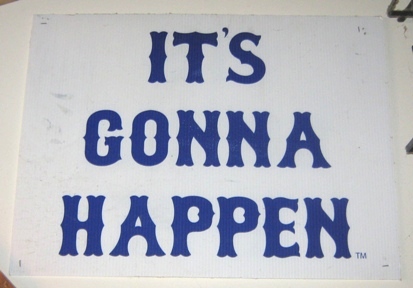
It did.
The book mainly focuses on the story of the Cubs’ 2008 season, with some side tales of Cubs fan agony. It’s the centennial of the team’s last World Series championship (yes, that was in 1908), but it’s also a season where fans believe the team has the best chance to break the curse that befalls them, with pitchers like Carlos Zambrano, Ryan Dempster and Carlos Marmol, and position players like Derrek Lee, Aramis Ramirez and Kosuke Fukudome.
Despite that the Cubs won 97 games and the NL Central Division in 2008, though, Sullivan never seems to believe that the Cubs will achieve the ultimate glory—indeed he almost predicts an easy victory for the Dodgers, the Cubs NLDS opponent. It bears out, with the Dodgers whitewashing the Cubs 3-0 in the series. Another Cubs season, as he puts it, ending with a loss.
But it’s not all bad…the family actually meets Ryan Dempster over the winter.
“Waiting For The Cubs” concludes with the story behind the Fred Merkle boner that cost the Giants the 1908 pennant…seemingly the last time that the baseball gods smiled on the Chicago Cubs…and Sullivan does a better job than most at clearing up what really happened that day at the Polo Grounds.
Many books have been written about the Chicago Cubs and their futility, but few of them capture the mind of the Cubs fan. Sullivan does it perfectly, making the story both personal and universal. No Cubs fan reading this book would disagree.
Nor, in fact, would any baseball fan. Highly recommended, whether you’re a fan of the Cubs, White Sox or Cardinals.
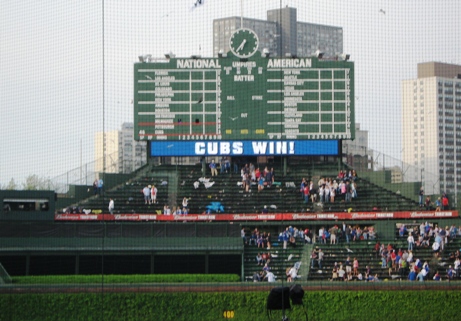
You can still hear Harry saying it.
(Note: this article contains affiliate links. If you use an affiliate link to make a purchase, Ballpark E-Guides earns a commission. Thanks for your support.)
Take A Rickshaw To Fenway – Boston Pedicab
Posted by Kurt Smith
If you’re looking for a cool or romantic way to get to Fenway Park, try those fun guys at Boston Pedicab.
As you may know, only rookies drive their car to Fenway Park, or anywhere in Boston, for that matter. Narrow streets and world-class congestion make the public transportation system pretty popular in Beantown.
But public transit has its drawbacks, especially for those using it to get to a ballgame. I can tell you from the experience of nearly having my face pressed against a window for entire Green Line rides. Trains coming to and leaving games at Fenway Park get mercilessly jammed with Red Sox fans.
So now we have rickshaws as an option…
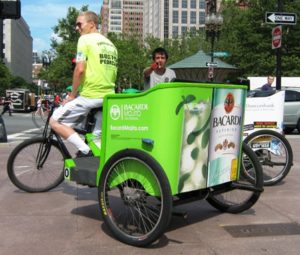
The perfect size vehicles for Boston streets.
Boston Pedicabs is a local outfit that employs college students, who pedal bicycles attached to rickshaws around the city. There are plenty of them available near Fenway, but the gentleman I e-mailed asking where best to find them (forgive me for losing the e-mail with his name) informed me that the Prudential Center garage some blocks east of Fenway is a good spot.
Gametime has your cheap Red Sox tickets…with a lowest price guarantee, panoramic seat view photos, and great last minute deals…even after the game starts!
(See why Ballpark E-Guides loves Gametime here!)
The Pru lot is much cheaper than the lots closest to Fenway, and the Center is basically a mall with quite a few good pregame dining options.
The fellows riding the bicycles are friendly and will have a conversation with you as they’re pedaling you through murderous traffic to the park, and you can look around at the city rather than waiting for the driver in front of you to finally move.
Best of all, they’re free. But not really. The Boston Pedicab drivers subsist entirely on tips, so don’t be stiffing them.
That’s just one cool way to get to Fenway…but you should really know every way to get there, because Fenway is a challenge.
Boston Pedicabs website: www.bostonpedicab.com
Taking a trip to Fenway Park? This amazing Fenway Park guide will tell you everything you need to know…how to get tickets, choose a seat, get to the game and what to eat, and how to save money on all of it!
(Note: this article contains affiliate links. If you use an affiliate link to make a purchase, Ballpark E-Guides earns a commission. Thanks for your support.)
The Fenway Frank – As Baseball As Life Gets
Posted by Kurt Smith
The Red Sox have upped their food game of late, with adding such fancy items like fluffernutter fries and Mings Bings, but the Fenway Frank is still essential sustenance at Boston’s venerable ballpark. Keeping it simple is why Fenway Park has lasted so long.
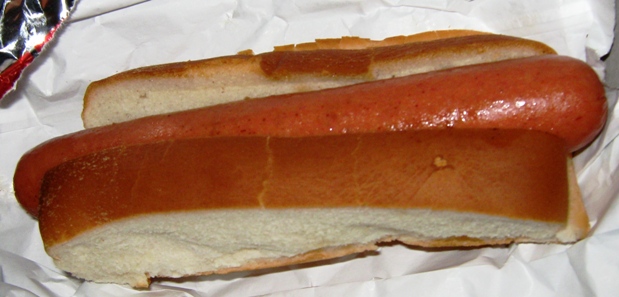
The white bread bun. Only at Fenway.
I don’t understand why it’s so rare to see a hot dog in a mushy white bread bun, but it’s part of what makes this baseball hot dog so distinctive – that gooeyness around the classic baseball flavor.
The Fenway Frank is made by Kayem Foods, who added some garlic and smoke to the flavor when they took it over in 2009. Incidentally, Kayem also makes the dogs sold at Tropicana Field in Tampa Bay, but they claim it’s a different style of dog. I would hope so.
Gametime has your cheap Red Sox tickets…with a lowest price guarantee, panoramic seat view photos, and great last minute deals…even after the game starts!
(See why Ballpark E-Guides loves Gametime here!)
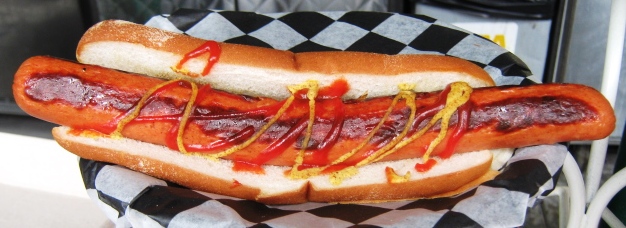
Is that “mmmmmm” that they’re spelling with the mustard?
You can also get a Monster Dog, which is an elevated Fenway Frank – and is quite large at ten inches. Save some room for that.
Regarding the franks sold in the stands, by the way, they are boiled in water as opposed to grilled on rollers like at the concession stands. I like my dogs boiled, but I think I’m in the minority on that. Either way, the Fenway Frank is the essential “Fenway Park food thing.”
Incidentally, the Red Sox and Kayem celebrate National Hot Dog Day in July. People submit their variations to be chosen as the Next Fenway Frank, and that creation gets sold at the ballpark the rest of the season.
In 2017 it was a North End Frank: topped with pesto, arugula, roasted red pepper, sun-dried tomato and fresh mozzarella. Now that’s a hot dog.
But the same could be said about the simple classic Fenway Frank.
(Note: this article contains affiliate links. If you use an affiliate link to make a purchase, Ballpark E-Guides earns a commission. Thanks for your support.)
Memorial Stadium: What Really Made It Special
Posted by Kurt Smith
In his excellent book “Ballpark: Camden Yards and the Building of an American Dream”, author Peter Richmond briefly discusses the emotional passing of Baltimore’s Memorial Stadium. He sums up the attachment Orioles fans had to 33rd Street by saying “it was what happened on the field that made Memorial Stadium special”.
I’ve seen this sentiment echoed in other places, and in remembrance of a great ballpark, I respectfully disagree.
(Pssst…interested in knowing everything about Oriole Park? Check out my complete guide to Camden Yards here!)
Without being critical of Richmond, he somewhat implies that Memorial Stadium wasn’t a great place to see a ballgame. And while his statement about the events on the field was true to an extent, as any O’s fan would acknowledge, it wasn’t the whole truth. A true Memorial Stadium tribute deservedly praises what was a great place for a night of baseball.
To fully appreciate how great Memorial was, consider the period that it lived in.

Are you SURE we’re going to a baseball game?
The Orioles played on 33rd Street from 1954 through 1991. 30 miles south, the Washington Senators began playing in cavernous D.C. Stadium (now RFK) in 1962, and played there through 1971 before moving to Texas and becoming the Rangers. Meanwhile, about 90 miles north in Philadelphia, the Phillies moved into Veterans Stadium in 1971—another venue designed more for football than baseball.
The multipurpose donuts that baseball fans sneered at for years were actually fairly popular when they first burst on the scene. With Busch in St. Louis, Three Rivers in Pittsburgh, Riverfront in Cincinnati, and many others, cities and teams went the route of football stadiums that could be tweaked for baseball, with easy to maintain carpeted fields and locations near an airport.
Nowadays, ask most baseball fans what the worst venues are, and two names pop up frequently: Tropicana Field in Tampa Bay with its carpet and roof, and O.Co Coliseum in Oakland with its “Mount Davis” grandstand tactlessly tacked on for Raiders fans. During its tenure as home of the Florida Marlins, Sun Life Stadium usually ranked pretty high too.
Memorial Stadium, on the other hand, seemed to be designed more as a venue for baseball than football. Fans would tell you it wasn’t great for football, even as it earned the nickname “The World’s Largest Outdoor Insane Asylum” during the Colts’ glory years. This became even more pronounced when the Colts moved out of town, and the Memorial Stadium baseball field was no longer stained by the yard lines of a lesser sport in Septembers.
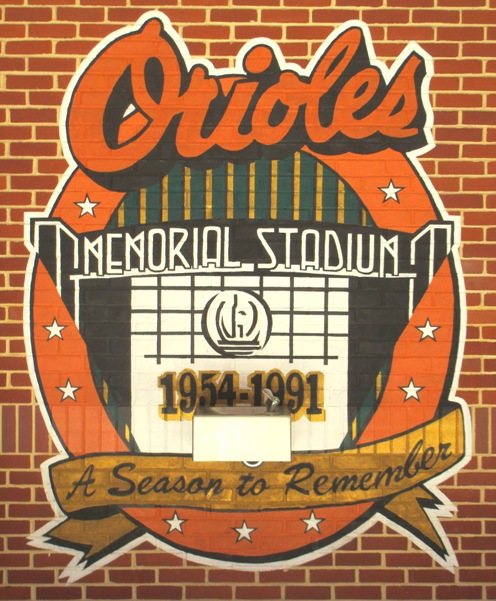
The “water fountain” dedication.
As a young baseball fan growing up in the Philadelphia area, the two-hour trip to Baltimore and an Orioles game was light years ahead of seeing a game at the concrete donut in Philly on the happiness meter. From top to bottom, everything seemed more special in Memorial.
It was smaller and humbler. It had a much more attractive brick façade on the outside, with a stunning and poignant dedication to World War II soldiers that I never neglected to read as we waited in line to get in.
It was in a residential neighborhood, which made parking difficult but was much easier to look at. The light towers stood majestically over the field, the first element of the ballpark to come into view after a seemingly endless ride on Loch Raven Boulevard.
Inside, the field was smellable grass, the seating almost everywhere featuring a pleasant background of the houses beyond center field. The hot dogs weren’t just hot dogs—they were Esskay Superdogs…what happened to them? (I’ll put the Esskay Superdog up against the Fenway Frank or Dodger Dog any day of the week, but that’s a biased O’s fan talking.)
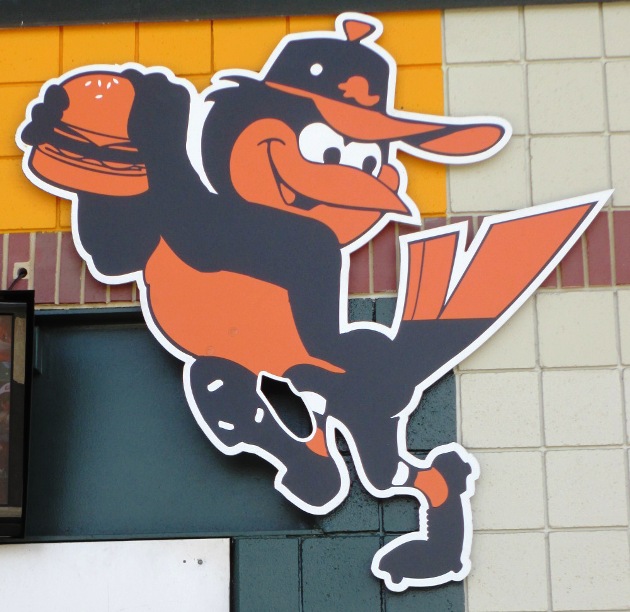
The classic cartoon Oriole.
Sure, what happened there was baseball greatness. Part of what made being an Orioles fan special was a great team full of lovable characters. Of course Birds fans loved Brooks Robinson’s superhuman reflexes at third base, Jim Palmer’s perfectly graceful windup, and Earl Weaver’s manic fury with umpires.
The team was full of unsung heroes too in my youth—like steady outfielder Al Bumbry, the classic platoon of Gary Roenicke and John Lowenstein, goaltender and team leader Rick Dempsey, and solid relief pitchers like Tippy Martinez and Don “Fullpack” Stanhouse (so nicknamed for the amount of cigarettes Weaver would smoke when he was on the mound).
There was nothing like Orioles Magic and teams that won so frequently with late-inning heroics. Being an Orioles fan was special, something you felt no other team’s fans had, not even Yankees fans.
But all of that was a huge bonus. Memorial Stadium was distinguished as a venue too, and just as much so when the Orioles faltered in the 1980s. It sat on 33rd Street, not being flashy, not going along with all of the modern, economically friendly and equally sterile venues of the 70s and 80s that treated baseball as a secondary sport. Had it lasted as long as Tiger Stadium or Comiskey Park, it may have been just as revered.
It was grass. It was open. It was bricks. It was all of the things teams eventually realized that they had forgotten in their concrete and plastic new homes. For a ballgame, few places were better than Memorial Stadium in its day. Of all of the stadiums back then, it was one of the few that actually didn’t need replacing, at least on baseball-friendliness grounds.
When Oriole Park at Camden Yards opened in 1992, it was a spectacular triumph and instantly won over baseball fans everywhere. It is still today one of baseball’s best venues.
But it had to be. Orioles fans my age remember the shoes it had to fill.
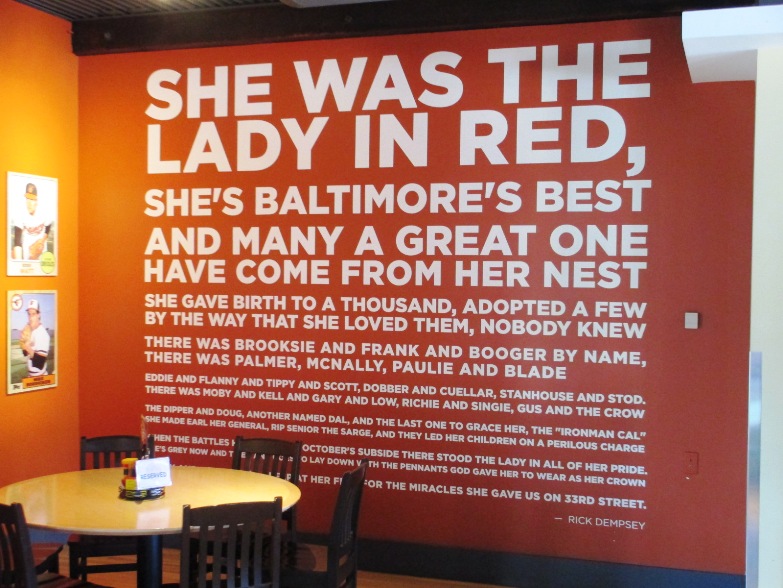
Rick Dempsey’s poem dedicated to the pile of bricks on 33rd Street.
(Note: The link at the beginning of this article is an affiliate link, through which Ballpark E-Guides earns a commission. Thanks for your support.)
Want to know more about Camden Yards? Sign up here for my completely free Oriole Park e-mail newsletter series, and score some seriously valuable info about tickets, seating, transportation and food…see you at the Yard!
How To Save Money On Playoff Tickets
Posted by vlm
The MLB Playoffs are here, and of the six division winners that have already punched their tickets to the postseason, only one…the Boston Red Sox of all teams…have seen a World Series championship since 1988.
Four of these teams haven’t even won a World Series in the ballpark they currently play in…that includes the Cubs…and two teams still haven’t grabbed a World Championship ring in their history. So playoff tickets will be in high demand.
Actually that’s a bit of an understatement. Cubs World Series tickets, should they make it, are starting at $2,000 for standing room.
It may be a little late for some of these tips to be useful, but file this away for next year, because if you’re seeking playoff tickets you can save a boatload of money by planning ahead:
1) Pay attention to the team newsletter.
You should always be signed up for a team’s ticket alert newsletter for any ballpark you plan to visit, of course, but the newsletter will let you know a) when season ticket holders can buy playoff tickets, since they will get first crack at it, and b) when the rest of us can buy tickets through the team, which will most certainly be cheaper than going through the markup.
Most teams give playoff ticket opportunities to folks who put down a deposit on a season ticket plan for the following season. This might be worth considering…you may want to get a friend or two in on it or sell your unwanteds on StubHub. If a team that hasn’t been good in a while suddenly goes deep into the playoffs, chances are good that tickets for the following season will go for much dough on the third party market.
But even if you have no season ticket aspirations, there will be some tickets still available through the team, and you’ll get an e-mail letting you know when they go on sale. You’ll have to be ready to jump on it as soon as they do, but the markup especially for teams like the Cubs will be significant…count on it being at least double the face price.
By the way, the team might hold a contest or an auction for playoff tickets, as the Cubs are doing…
2) Keep checking with the team.
It does happen; players and officials return their extras. Maybe not as much for critical games, but you never know. The point is to remember that playoff tickets especially will almost always be cheaper going through the team than through an agency or a third party.
3) Go for the “if necessary” games.
In my searches I noticed that when teams are making division series tickets available, the tickets for the first two “necessary” games go far more quickly than the game five or whatever tickets. So look into this option if you don’t absolutely have to go; you’re more likely to land a better seat at face price.
The team will refund whatever amount you pay for games that don’t get played (I presume that includes the fees), small consolation for missing the playoff game, but at least it’s safe.
4) Remember the third party market rules.
If you have to go through StubHub or Gametime rather than through the team, you’ll be paying more, obviously, but you at least don’t have to submit to the team’s season ticket demands.
Remember basic rules for using third party sellers: wait until about 2-5 days before the event to pick up tickets, or till the last minute if it isn’t that important to you, and be ready to snap up a good deal if one appears (hard to gauge, I know, just be realistic).
Also, be sure to go all the way to the checkout screen to compare prices; Gametime includes the fees in the displayed cost if you toggle “all-in pricing”, but StubHub does not, and you may be very surprised at the difference between ticket prices in similar sections.
You can set alerts on StubHub, but thus far that hasn’t worked very well for me recently. Couldn’t hurt though.
5) Be extra wary of scalpers and Craigslist.
I’ve written before about buying tickets on Craigslist and the potential for fraud, and how it’s generally not worth worrying about being scammed. It’s the same with scalpers. There are some things to know dealing with both, but the large majority of the time they are legit.
During the playoffs, though, when the stakes are higher and the costs of tickets skyrocket, you will occasionally read stories about scalpers and people on Craigslist selling fake tickets. I’m betting we may hear a story about this in Chicago. Just be extra careful.
6) Consider going on the road.
Let’s say you’re a die-hard Cubs fan who can’t put a second mortgage on their house to see a postseason game at Wrigley. Why not look into a trip to D.C.? Or L.A.? Or for that matter, Detroit? The Tigers could still make it as I write this, and we could see a World Series between two teams that are just a four-hour drive apart.
Since you’re reading this now for next season, if you think going to see your heroes on the road might actually be cheaper than seeing your team at home, sometime in mid-August…mark August 15 on your calendar…you should subscribe to the team newsletters of any team you think might make the playoffs. Remember, tickets will almost always be cheaper through the team.
Again, these tips may probably only be slightly helpful now, but if you want to get playoff tickets without losing your shirt, most likely you’ll have to plan well ahead anyway (I’ll re-post this earlier next time). So look into splitting a season ticket deal with a friend (you should probably share the postseason tickets too, just saying), subscribe to team alerts, and get your best practices on with StubHub.
Parking For Free At The Ballpark
Posted by vlm
Recently I interviewed Scott Chamberlain, a prominent member of Ballpark Chasers, and someone who has accomplished a pretty remarkable feat in 2016…he has paid just $2 for parking all season!
Scott graciously took the time to answer my questions and share his tips; hope you enjoy the exchange below.
How many games did you go to this year, and at how many ballparks?
Up to this point, I am at 61 regular season MLB games at 8 different MLB parks and 155 sporting events on the year. I am at a slight disadvantage location-wise as I live in Indianapolis. I say slight because I have six MLB teams within a 4 1/2-hour drive of me yet none within 100 miles from my doorstep. Last season, I attended 143 MLB regular season games at all 30 MLB parks.
How did you find free parking? You can give me a couple of examples. Did you have a long walk in these cases, or were you going through unsavory areas of town?
I find free parking by trial and error. I have become very adept at reading street signage to be absolutely sure that a spot is free. For instance, on the south side of Chicago…there are a few blocks along 31st street that are free at all times and some that have the dreaded pay box. I’ve yet to receive a ticket as I would hate to see a “free” spot become a costly ticket.
Another good example is Wrigleyville. For day games, you can park on most streets around the stadium for free until 5pm. After that, the tow trucks are out in full force. There are some main roads that have free parking at all times. These you have to walk 8-10 blocks but it’s a lot better than paying $15-$40 to park.
Also, I’ve found spots after doing research online or talking with fellow ballpark chasers. My favorite free spot find was given by a fellow ballpark chaser and close friend. They suggested a road southwest of Safeco Field near the port area. Sure enough, a simple six block walk to the stadium was all that was needed. And rather than fight traffic on the way out, it was strategically placed to where I could head south and onto the highway a couple interchanges down I-5 from Safeco.
Free parking is a must for me not only due to budget constraints but also ease of access. I don’t mind walking a mile or so in exchange for beating traffic around the stadium. However, safety is a concern and I will avoid unsavory areas. Miami, Boston, and Dodger Stadium are the three stadiums that I’ve had to pay for parking or use mass transit for as I haven’t found free areas yet.
Where did you pay $2 and why?
The $2 charge for parking kind of sticks in my craw a bit in hindsight. My drive from Indy to Cincinnati in May was longer than expected due to an accident on interstate 74. There was a bobble head that I wanted and I was worried about not getting it. I shunned one of my three “go to” free parking areas in exchange for rushing to the stadium for the giveaway. Even then, it was a metered spot that ended midway through the game so that’s where my $2 came from.
In retrospect, I wish I had parked in a usual free spot to have a perfect parking record this year.
You’re not cheating with this, right? No public transit or anything?
No cheating. When I did my 30 parks/143 MLB games last year, I kept a running total on every single travel expense from flights to parking to the Sunday morning hotel coffee before a game on getaway day.
What interested me about this exercise was the hidden expenses that are had. When going to Chicago for instance, I would always park at a CTA lot for five dollars and take the CTA train in. This would amount to an eleven-dollar move. Meanwhile, I was already in my car and for a few extra miles, could skip that move and park on the street.
New York and Boston are the only cities where I skip driving to games due to traffic or ease of access via mass transit. However, if you are wanting to do a NY/Philly doubleheader, street parking can be had in NY and Philly for a quick get-away.
What do you suggest for someone looking to park for free at the game? What are the hardest ballparks to find free parking, and which are the easiest?
If a fan is going to a game on a budget, parking fees can be a nuisance. I’d suggest arriving a couple of hours early and driving around a little to find good spots. The areas a block or two from the stadium are not necessarily convenient when you consider leaving after the game and fighting outbound traffic.
The easiest parks to find free parking are ones situated in a downtown area. I’ve found that parking on edges of downtown areas and casinos have helped.
The hardest parks have been Boston, LA Dodgers, and Miami.
Do you hope to park completely for free in 2017?
I certainly hope so. I try to go to as many games as possible. It helps the budget to not have to pay to park. Money saved here can go towards a food or drink item at the yard!
How I Saved $75 At Citizens Bank Park
Posted by Kurt Smith
I live in South Jersey, about a 15-minute drive from Citizens Bank Park. Recently a few of my wife’s relatives visited from North Carolina, and they asked me about going to a game, since none of them had yet seen the “new” Philly ballpark.
I get nervous about things like this, since I have something of a reputation to keep. But we did fairly well.
Gametime has your cheap Phillies tickets…with a lowest price guarantee, panoramic seat view photos, and great last minute deals…even after the game starts!
(See why Ballpark E-Guides loves Gametime here!)
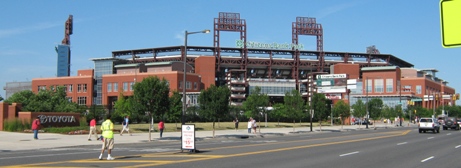
Where’s the concrete?
There were five of us, and I saved us $11 each on the face price of tickets with SeatGeek ($55 total), and found them a parking spot that was $6 cheaper than the Phillies lots (and closer to the ballpark than some of them).
On the way to the game we stopped at a produce shop for a $3 bag of peanuts that was enough for everyone, so that probably saved about $9 if we had bought peanuts inside. I saved $4.50 myself on a free soda.
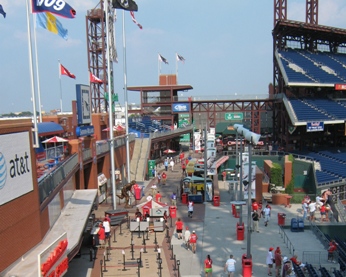
“Now if you squint really hard here, you can see the Bull.”
Inside the ballpark I was something of a tour guide, answering all of their food questions…Wayback burgers, Tony Luke’s, the Schmitter, Federal Donuts, etc. There were two young ones with us that enjoyed the explanation of the neon Liberty Bell in right field.
We had great seats, in the 12th row just behind first base, and they got to try the classic cheesesteaks: the Tony Luke’s with provolone and the Campo’s “Heater”.
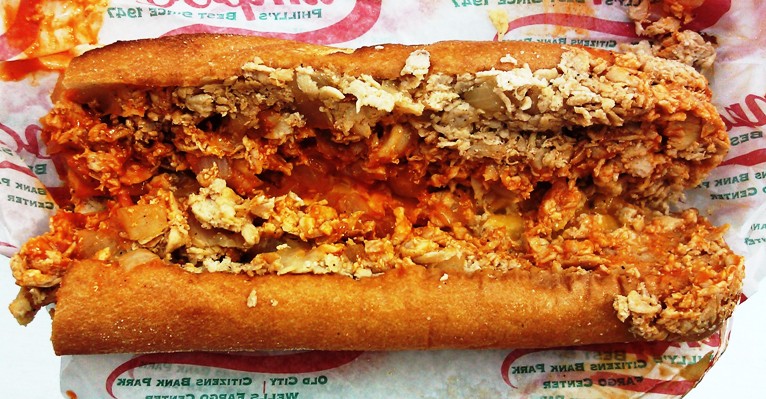
Now you know you’re in Philly.
A great time was had by all, followed by a very easy exit out of the parking lot back onto the highway. All for about $75 less than it normally would cost.
I’m not trying to brag here. Well okay, I am a little bit. I was pleased enough with the accomplishment that I literally considered hiring myself out as a Baseball Fan Consultant. <grin>
But think about what it costs to gather a group for a ballgame…the tickets, the parking, the food, souvenirs etc. You’re probably going to do that sometime in the future, or at least be part of such a group, right? Now imagine shaving $75 off of that total cost.
What could you do with that $75 while you’re in town? Get a nice souvenir, like a jersey? Enjoy a nice meal in Center City? Or even get yourself some gray sweats for the authentic “Rocky running up the Art Museum steps” experience?
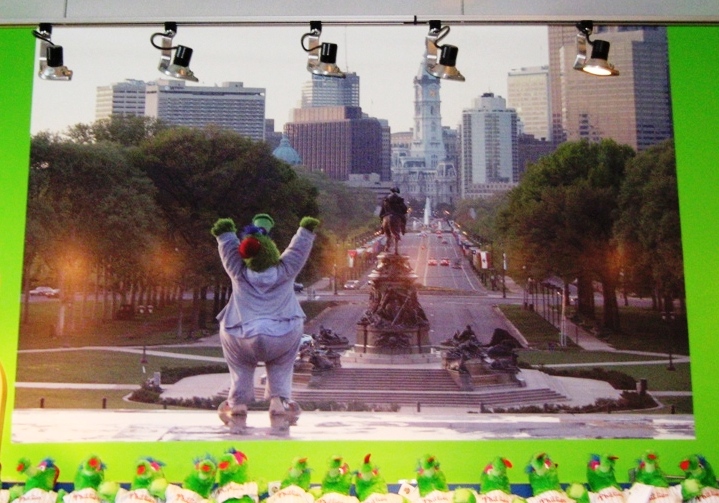
True Philly genius.
Your mileage may vary, of course.
That’s just one case study…I will be including more in the future. But needless to say, I’m here to help.
(Note: this article contains affiliate links. If you use an affiliate link to make a purchase, Ballpark E-Guides earns a commission, at no extra cost to you. Thanks for your support!)
Megabus – Great For Traveling Fans
Posted by Kurt Smith
So you have no problem taking a 4-5 hour trip to see your favorite team in another ballpark, right?
For fans whose home ballparks are outrageously expensive to visit, like Cubs and Red Sox fans, it’s a popular thing. Much of downtown Baltimore’s hospitality industry is dependent on Red Sox and Yankees fans that visit Camden Yards 21 times a year.
If you want to save a boatload of money on such trips, try a Megabus.
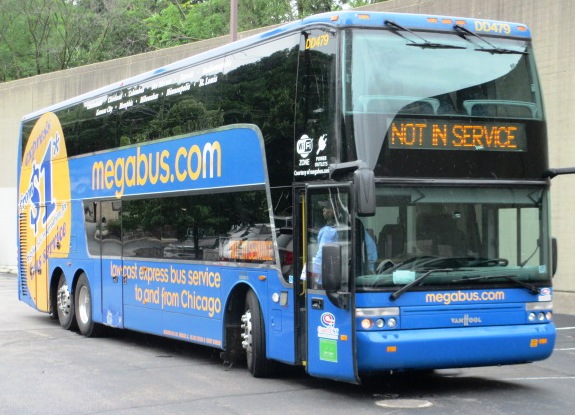
Just saying, when they’re in service they’re great.
Megabus is a luxury bus service available now in about 50 cities in the U.S. and Canada (and in the U.K. even, but anywhere they don’t play baseball doesn’t matter). They have single and double decker buses, all of which have Wi-Fi and free plug-ins. And they do it all for a ridiculous price, sometimes as low as $1. You have to book such deals well ahead of time, but that’s worth the trouble.
Megabus operates from popular transportation hubs in large cities, so your only part of it is getting to the transportation center. In my home town of Philadelphia, that would be the 30th Street Amtrak station. With most ballparks in downtown areas these days and easily reachable by public transit, you should be able to leave the car at home and save a ton.
I’ve used Megabus a few times with great results, but my favorite example is when I used one from NYC to Boston…for just $2.50 round trip. I found a couple of $1 fares and the fee was just 50 cents.
Between gas and tolls, driving that distance would cost at least $50—assuming you are using your own car. And that’s not figuring in the aggravation of the traffic, which is always bad in Connecticut and usually bad near New York and Philadelphia. Not dealing with that is certainly worth a few extra bucks. Did I mention the price of parking in Boston?
Four hours is a long time to ride on a bus, but Megabuses are clean, air-conditioned and comfortable, with free Wi-Fi to keep you busy. You can take care of all that other business you are too busy driving to do, or you can go onto the upper level and enjoy the panoramic view. You’re allowed one piece of luggage and a carry-on bag, which for a weekend trip should be plenty.
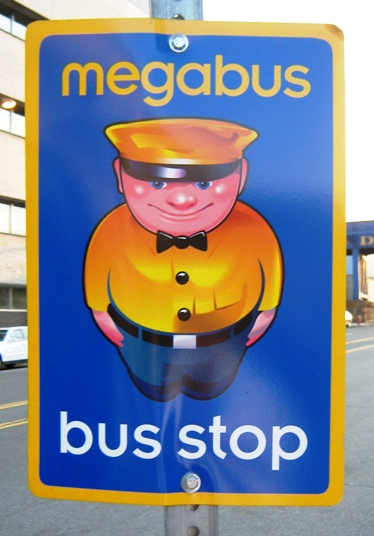
He may be small, but he looks friendly enough.
Megabus covers most major cities in the U.S. and Canada. In most cities (not all, but most) they’ll drop you off near a public transportation hub that will get you anywhere else in the city in short order, certainly to the local ballpark.
It isn’t perfect, according to some reviews I’ve read…sometimes buses are late (honestly…is there a bus service that’s always on time?), and a few people have complained that the Wi-Fi doesn’t always work.
But I personally have never had a problem with them, and to get from New York to Boston and back for practically nothing? I’ll take it.

